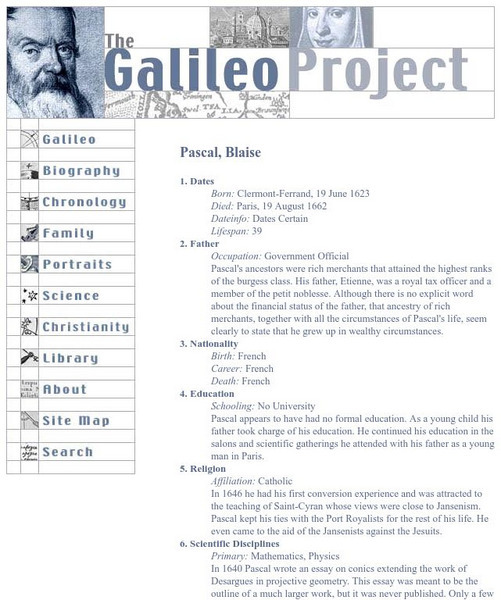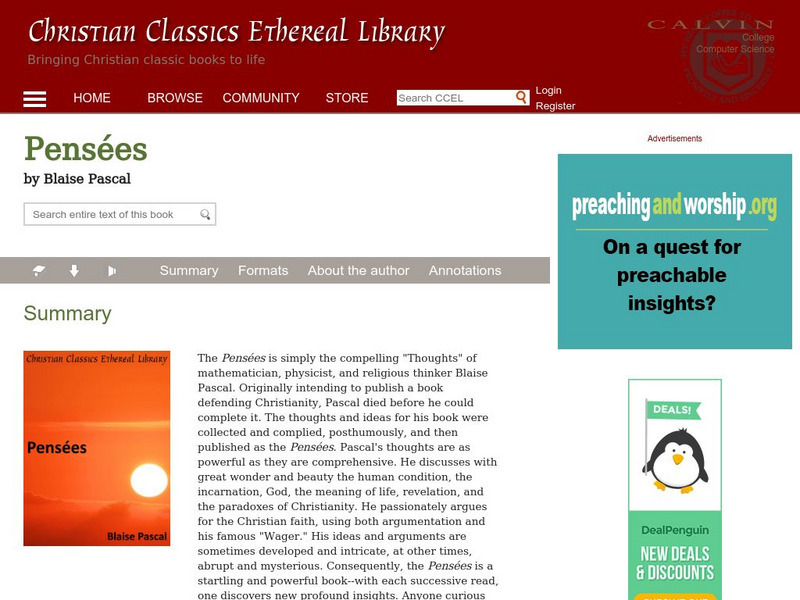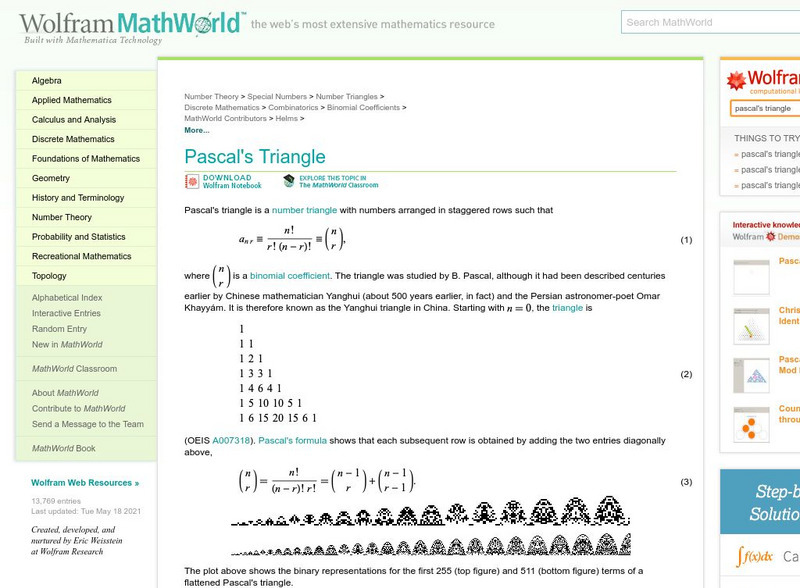Hi, what do you want to do?
Rice University
Galileo Project: Blaise Pascal
This site from The Galileo Project of Rice University provides information on ten fields of biographical data which are compiled regarding Blaise Pascal, including dates (birth/death), father (occupation/wealth), nationality, education,...
Oregon State University
Pascal's "Provincial Letters"
Complete text of Pascal's "Provincial Letters," organized in a table of contents.
Christian Classics Ethereal Library
Uwm Libraries:text of Pascal's "Pensees"
Entire text of Pascal's 1660 Pensees essay(s).
Wikimedia
Wikipedia: Blaise Pascal
A Wikipedia encyclopedia article on Blaise Pascal (1623-1662 CE) gives an overview of his contributions to math and physics. It also discusses hisabadonment of the two subjects for religion.
Steven Kreis, PhD
The History Guide: Blaise Pascal
This site provides a substantial biography of Pascal with excerpts from "Pensees," and the entire text of "Provincial Letters."
Wolfram Research
Wolfram Math World: Pascal's Triangle
This site from MathWorld provides great information on Pascal's Triangle. Links are provided throughout for additional information, along with several helpful charts and formulas. This is a good site to check out on the subject.
Instituto Latinoamericano de la Comunicacion Educativa
Red Escolar: El Triangulo De Pascal
In Spanish. Find out about the life of Blaise Pascal who discovered the famous Pascal triangle. Use their interactive activities to learn how to fill out the Pascal triangle.
Curated OER
Science Kids: Science Images: Blaise Pascal
This image is of French physicist Blaise Pascal. He developed work on natural and applied sciences as well being a skilled mathematician and religious philosopher.
Curated OER
Smithsonian Libraries: Scientific Identity: Blaise Pascal (1623 1662)
A portrait of Blaise Pascal from the Dibner Library of the History of Science and Technology, made available through the Smithsonian Institution's Scientific Identity Collection.
Curated OER
Smithsonian Libraries: Scientific Identity: Blaise Pascal (1623 1662)
A portrait of Blaise Pascal from the Dibner Library of the History of Science and Technology, made available through the Smithsonian Institution's Scientific Identity Collection.
History of Computing Science
History of Computing Science: First Mechanical Calculator
Blaise Pascal, the seventeenth-century French mathematician, thinker, and scientist, built the first mechanical adding machine in 1642 based on a design described by Hero of Alexandria (2 CE) to add up the distance a carriage traveled.
Great Idea Finder
The Great Idea Finder: Adding Machine
The Great Idea Finder profiles the adding machine, invented by nineteen-year old mathematician Blaise Pascal in the year 1642.
Curated OER
University of St Andrews: Blaise Pascal
This University of St. Andrews site contains biographical information and achievements of Blaise Pascal.
Curated OER
University of St Andrews: Blaise Pascal
This site from the University of Saint Andrews provides a short biography of Pascal. Takes a philosophical angle. Features links to existentialist philosophy, seventeenth and eighteenth century literature, and philosophy pages.
History of Computing Science
History of Computing Science: The First Mechanical Calculator
The Pascaline was the first mechanical adding machine and was developed by Blaise Pascal. This lecture series presents a brief description of the history of the machine and how it worked.
University of South Florida
Educational Technology Clearinghouse: Lit2 Go: History of Mathematics
Short selections from W. W. Rouse Ball's "A Short Account of the History of Mathematics," most of which are biographies that focus on the mathematician's work. The text can be read online or downloaded by individual chapters in MP3 or...
Oswego City School District
Regents Exam Prep Center: Binomial Theorem
Students learn about the binomial theorem. The tutorial includes class notes, calculator tips, examples, and practice problems with solutions. The teacher resource investigates the origins of the binomial theorem.
University of Houston
University of Houston: Lesson Plan: Famous Mathematicians
This lesson plan is aimed at 7th and 8th grade students and involves researching famous mathematicians and the import of their contributions.
Curated OER
The First Mechcanical Calculator:
Blaise Pascal, the seventeenth-century French mathematician, thinker, and scientist, built the first mechanical adding machine in 1642 based on a design described by Hero of Alexandria (2 CE) to add up the distance a carriage traveled.
















